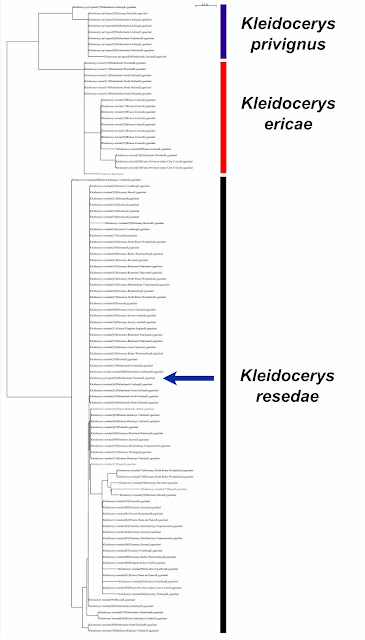I've been bothered about Kleidocerys for a while - specifically, is Kleidocerys ericae a separate species from the familiar Birch Catkin Bug, Kleidocerys resedae? See: The Kleidocerys Conundrum. When I cogitated about this two years ago it was obvious that DNA was the way out of the mess. A recent paper spurred me into action - time to find an answer.
In a nutshell, DNA barcoding is a method of identifying species by sequencing a short, conserved region of DNA. The ideal DNA barcode gene needs to have enough variation between species to tell them apart, but be conserved enough within a species so it can be easily identified. The 5' portion of mitochondrial cytochrome c oxidase subunit I (COI-5P) has become the standard Arthropod barcoding marker. A vast amount of DNA barcode data has now accumulated. At the time of writing, the International Barcode of Life (iBOL) initiative - www.boldsystems.org - has examined 26 million specimens, 21 million of them from Arthropods. Helpfully, the BOLD website makes it (relatively) easy to examine them, so I plunged into looking at the Kleidocerys data.
CAVEAT: It's been a while since I did this professionally, and even then, it wasn't really my specialism. What follows is my interpretation. Others reading this may well know far more about it than I do, in which case, please let me know.
A DNA dendrogram - tree diagram (if it was good enough for Darwin to sketch in his notebook, it's good enough for me) - is a visual representation of the genetic relationships between different organisms, or in this case, DNA sequences. Here's the tree for the Kleidocerys COI-5P barcodes:
(click for larger image)
In summary:
- Kleidocerys resedae and K. ericae each form sequence clusters with similar levels of relatedness. This supports the idea that they are indeed separate species.
- Kleidocerys privignus, very similar in appearance to K. resedae but which is said to occur on Alder, also appears to to be a separate species. (NB: one privignus sequence clusters within the resedae sequences (blue arrow) - presumably a misidentified specimen).
So what does it mean for me? That I probably need to keep looking for K. ericae, although it is possible that it may not occur in VC55. I've been told that K. resedae can occur anywhere, but K. ericae is only found on Erica species (and not on Calluna), that that may help to target the search. It also means that I should probably look for K. privignus - time to target the Alders this year.
Has this made my life simpler? Nope. When did technology ever do that?

No comments:
Post a Comment
Comments welcome, I will respond as soon as I can.